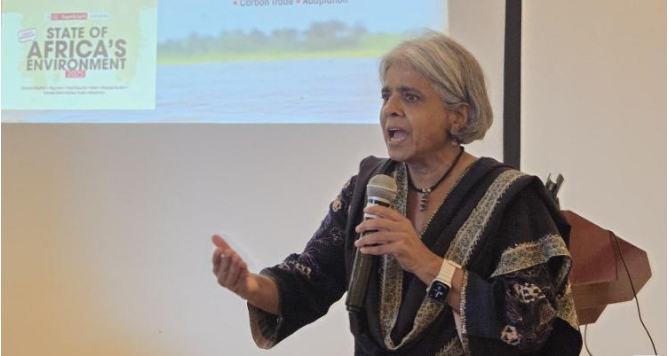
 Sunita Narain, Director General of CSE, during the launch of the State of Africa’s Environment 2025 report in Addis Ababa/AGATHA NGOTHO.
Sunita Narain, Director General of CSE, during the launch of the State of Africa’s Environment 2025 report in Addis Ababa/AGATHA NGOTHO.
Recurring droughts have forced pastoralist communities in Turkana, Marsabit and Garissa to move in search of pasture and water, while devastating floods along the Tana River and in Budalang’i have displaced families time and again.
A new report warns that these local experiences reflect a wider continental crisis.
The State of Africa’s Environment 2025 report projects that by 2050, up to five per cent of Africa’s estimated two billion people—nearly 100 million—could be forced to migrate due to climate stress.
Released by the Centre for Science and Environment (CSE) in partnership with Down To Earth magazine, Alliance for Science–Ethiopia and Media for Environment, Science, Health and Agriculture, the report shows that Africa’s youthful population, averaging just 19 years, will face unprecedented climatic disruptions where migration becomes the new normal.
Global data from the Internal Displacement Monitoring Centre (IDMC) revealed that disasters triggered nearly 265 million displacements between 2015 and 2024, with 90 per cent linked to floods and storms.
Africa, the report noted, has been among the hardest hit.
“Internal displacements have tripled in the last 15 years and climate-related disasters alone have driven a six-fold increase in forced movement. Floods account for over 75 per cent of Africa’s disaster displacements, while droughts contribute about 11 percent,” it showed.
In Kenya and across eastern Africa, most climate-related displacements occur during rainy seasons.
IDMC data showed that the March–May 2024 long rains displaced over 500,000 people between October 2023 and January 2024.
By the end of 2024, around 185,000 people remained in internal displacement, 131,000 of them due to drought.
Experts describe this phenomenon as “climate mobility,” where migration becomes both a coping mechanism and an adaptation strategy.
The Intergovernmental Panel on Climate Change notes that while migration can help households adjust, outcomes depend heavily on social, economic and governance factors.
“For most Africans, migration is not across borders but short distances within their own countries, often to nearby towns or safer rural areas,” the report explained.
“Cyclones Idai and Freddy, repeated droughts in the Horn of Africa, and worsening floods across Kenya and Nigeria highlight what lies ahead.”
By 2050, the International Organization for Migration projects as many as 200 million additional “environmental migrants” worldwide, with Africa at the epicentre.
Sunita Narain, director general of CSE, stressed that climate migration is no longer a distant scenario but a lived reality.
“The question is not whether millions will move, but how governments and communities can prepare to manage this inevitable human mobility,” she said.
“Each year, each month, extreme weather is breaking a new record. I call this the revenge of nature. But we have no option except to stay on course.”
Instant Analysis
According to the UN Refugee Agency (UNHCR), weather-related disasters have triggered an average of 60,000 displacements every day over the past decade. The UN’s World Migration Report 2024 underscores that while climate change is not the sole driver of migration or food insecurity, it magnifies existing vulnerabilities tied to governance, inequality, and fragile food systems.

















